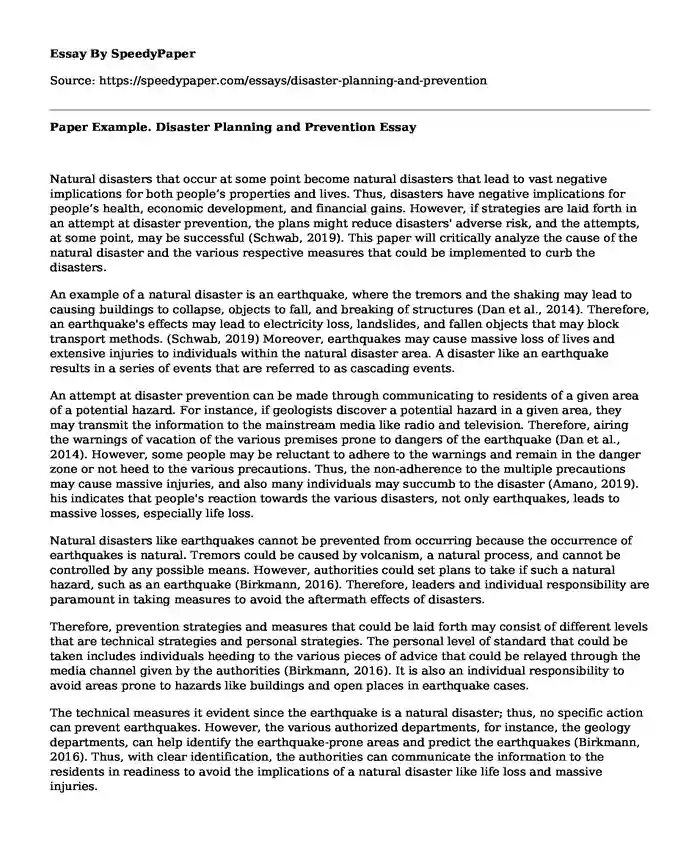
| Essay type: | Problem solution essays |
| Categories: | Planning Security Disaster |
| Pages: | 3 |
| Wordcount: | 694 words |
Natural disasters that occur at some point become natural disasters that lead to vast negative implications for both people’s properties and lives. Thus, disasters have negative implications for people’s health, economic development, and financial gains. However, if strategies are laid forth in an attempt at disaster prevention, the plans might reduce disasters' adverse risk, and the attempts, at some point, may be successful (Schwab, 2019). This paper will critically analyze the cause of the natural disaster and the various respective measures that could be implemented to curb the disasters.
An example of a natural disaster is an earthquake, where the tremors and the shaking may lead to causing buildings to collapse, objects to fall, and breaking of structures (Dan et al., 2014). Therefore, an earthquake's effects may lead to electricity loss, landslides, and fallen objects that may block transport methods. (Schwab, 2019) Moreover, earthquakes may cause massive loss of lives and extensive injuries to individuals within the natural disaster area. A disaster like an earthquake results in a series of events that are referred to as cascading events.
An attempt at disaster prevention can be made through communicating to residents of a given area of a potential hazard. For instance, if geologists discover a potential hazard in a given area, they may transmit the information to the mainstream media like radio and television. Therefore, airing the warnings of vacation of the various premises prone to dangers of the earthquake (Dan et al., 2014). However, some people may be reluctant to adhere to the warnings and remain in the danger zone or not heed to the various precautions. Thus, the non-adherence to the multiple precautions may cause massive injuries, and also many individuals may succumb to the disaster (Amano, 2019). his indicates that people's reaction towards the various disasters, not only earthquakes, leads to massive losses, especially life loss.
Natural disasters like earthquakes cannot be prevented from occurring because the occurrence of earthquakes is natural. Tremors could be caused by volcanism, a natural process, and cannot be controlled by any possible means. However, authorities could set plans to take if such a natural hazard, such as an earthquake (Birkmann, 2016). Therefore, leaders and individual responsibility are paramount in taking measures to avoid the aftermath effects of disasters.
Therefore, prevention strategies and measures that could be laid forth may consist of different levels that are technical strategies and personal strategies. The personal level of standard that could be taken includes individuals heeding to the various pieces of advice that could be relayed through the media channel given by the authorities (Birkmann, 2016). It is also an individual responsibility to avoid areas prone to hazards like buildings and open places in earthquake cases.
The technical measures it evident since the earthquake is a natural disaster; thus, no specific action can prevent earthquakes. However, the various authorized departments, for instance, the geology departments, can help identify the earthquake-prone areas and predict the earthquakes (Birkmann, 2016). Thus, with clear identification, the authorities can communicate the information to the residents in readiness to avoid the implications of a natural disaster like life loss and massive injuries.
In summary, natural hazard may become natural disasters in that they have undesirable implications for economic and financial projects since natural hazards destroy massive lives and livelihoods. Thus, natural hazards cannot be prevented, but measures could be laid forth to prevent massive damages to natural hazards.
References
Alexander, D. (2015). Disaster and Emergency Planning for Preparedness, Response, and Recovery. Oxford Research Encyclopedia of Natural Hazard Science. https://doi.org/10.1093/acrefore/9780199389407.013.1
Amano, K. (2019). Evacuation Behaviors and Disaster Prevention Of “Residences For Elderly People With Service” In The Case Of Earthquake Disaster. Journal of Architecture and Planning (Transactions of AIJ), 84(765), 2247–2257. https://doi.org/10.3130/aija.84.2247
Birkmann, J. (2016). Urban and Spatial Planning in Natural Hazard Risk Management. Oxford Research Encyclopedia of Natural Hazard Science. https://doi.org/10.1093/acrefore/9780199389407.013.8
Dan, M. B., Armas, I., & Goretti, A. (2014). Earthquake Hazard Impact and Urban Planning—An Introduction. Earthquake Hazard Impact and Urban Planning, 1–12. https://doi.org/10.1007/978-94-007-7981-5_1
Schwab, J. C. (2019). Planning Systems for Natural Hazard Risk Reduction. Oxford Research Encyclopedia of Natural Hazard Science. https://doi.org/10.1093/acrefore/9780199389407.013.168
Cite this page
Paper Example. Disaster Planning and Prevention. (2023, Nov 27). Retrieved from https://speedypaper.net/essays/disaster-planning-and-prevention
Request Removal
If you are the original author of this essay and no longer wish to have it published on the SpeedyPaper website, please click below to request its removal:
- Student Athletes and Non-Student Athletes Essay Sample
- Biography Essay Examples
- Essay Sample Considering College Student-Athletes
- Essay Sample on Performance Management in the Public Sector, Non-Profit Sector, and Government
- Free Essay: Psychology Aspect of Aging
- LA Galaxy - Free Paper Example
- Manufacturing Industrial Location - Essay Example
Popular categories




